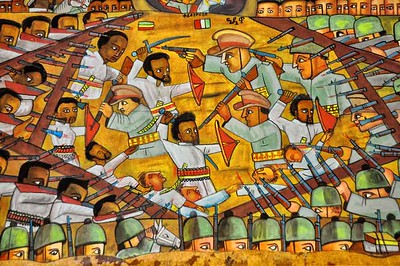Introduction
For this case study, I plan to discuss the Italian-Ethiopian war. The main idea is to argue that Italy not only waged war against Ethiopia, this war was actually a genocide attack on the Ethiopian race as a response to Italy’s defeat in 1896. To support this, I will discuss the horrors of the war and its consequences on Ethiopians. Questions I intend to answer are, why did the Italians wage war, how did they win the war, Ethiopians life during the war, and what lasting effects did the war have on Ethiopia. I plan to use primary sources from class regarding the war.
Spark of the Invasion
In order to understand why the Italians invaded Ethiopia, it is important to know the spark behind the invasion. Italian colonies held much political power in eastern Africa from the 1884 Berlin Conference, all except for the country Ethiopia. To avoid wars from breaking out among the western powers, the Berlin Conference also known as the Scramble of Africa, was formed. This three-month conference was spent dividing Africa into fifty irregular countries in a hodgepodge of geometric boundaries. To add to the cruelty of this Conference, there was the exclusion of African representatives. From the perspective of an African, their countries were taken over during this Scramble, without them even being present to speak on their behalf. This colonization of European control was not addressed again until the independence era in the 1950s-1960s in Africa. Although the Conference was in 1884, its effects played a role in the Italian-Ethiopian war. Because African countries were divided and given to western colonies in order to maintain or grow their power; the flame of colonization continued and was an underlying theme and reason on why Italy wanted more land to control; for land equals power. Ethiopia was the only uncolonized country in that area, and Benito Mussolini, creator of fascism and dictator of Italy, wanted to unify the other surrounding Italian colonies (Somaliland and Eritrea) and establish them as a large modern Roman empire in the independent African state. In order to colonize Ethiopia, Mussolini tried to take Ethiopia by force. In 1896, Italian troops invaded Ethiopia and were,
“resoundingly defeated by determined native force at the town of Adowa. The Italians lost 12,000 men. Of these, 1,705 had been captured as prisoners of war, and Italy was obliged to pay Ethiopia 10 million lire for their return. It was a humiliating defeat for a modern European nation. The Italians never forgot it and longed for revenge” (Osborne, 2001).
From the moment Mussolini was defeated, his plans for revenge were enacted. From 1935-1936, Mussolini’s plans came to action through a series of massacre attacks on Ethiopia as they still held control. The first attack was a counter response after the attempted assassination’s attack on Marshall Graziani, the Viceroy of Ethiopia. In response, Mussolini ordered that all Africans be killed on sight in the capital, Addis Ababa, resulting in the killing of thousands. The second massacre attack occurred in Debre Libanon, one of Ethiopia’s most important monasteries. Graziani ordered the execution of over 300 monks after discovering the links between monks and guerrilla fighters. The corpses of the monks remained unburied until the end of the war. The third attack occurred between March 14-April 12, 1939 three years after the war. From the first Italian-Ethiopian war, Italy had discovered that there was a strong partisan resistance that gained popular support. The Italian military did not want the guerrillas so close to the country’s capital, which became the main new arteries of the new Italian colony. To detain this operation, Mussolini wrote to the commanders that, “no truce is to be given to the runaway”. By this he meant that there was:
“no difference made between civilians and the military. Women, children and the elderly, who were part of the partisans chiefs retinues, were often bombed and gassed from the air when they tried to escape from the areas invaded by the Italians (Dominioni, 2008).”
This treatment of intentially killing innocent bystanders, nonviolent monks, a religion known to be peaceful, and children is a clear sign that these were acts of murder and genocide by using war as an excuse. By killing off innocents, and religious leaders, and the future generations, you are killing off the social and cultural factors that made up Ethiopian. War should remain on the battlefield, but this was not the case. By comparing these massacres to the Holocaust there are many similartites in the treatment of Jews and Ethiopians. In history books, this treatment is symbolized as a genocide, the same terminology should be used for the indiscrimatory treatment of Ethiopian civilians. In order to try to escape the massacre attacks, citizens took refuge underground.
Life underground during the war
The Abebe Aregai, followers that did survive, took refuge in underground caves. One being the cave of Zeret in the province of Manz. Many of those inside the cave were women, children, and the eldery. And while living underground, Ethiopians tried to reproduce their traditional way of living. This was a form of resistance by preserving their culture and identity against colonial Italian rule. Women were the backbone of ensuring survival and a healthy living in the caves. Not only was there a majority of females, but they were responsible for, “cooking, preparing and serving coffee, preparing butter, winnowing and grinding cereals, spinning cotton, carrying water, and transporting wood…preparing traditional beer” (Ruibal, Sahle, et. all, 2011). Without women, the culture and rituals for events such as beer making would have been lost from the war. Women’s duties directly represented Zeret’s culture. Many women are left out of history, yet they clearly had a presence and made huge contributions to the war. Men also played a crucial role in the safety of those in the cave. Their duties included plowing, making iron tools, building houses, and the main task to defend the cave.
Based on historical discoveries, the Abebe were intending the stay underground for a long period of time. Social life activities were carefully placed in their appropriate spots. Cooking was carried out near the mouth of the cave, drinking traditional beer, coffee, and eating were done in a comfortable well- lit area near the front of the cave, and the placement of animals. Animals were kept inside the cave to provide, dung fuel, meat, and warmth during the cold nights. Their advanced system of organization showed the intelligence and knowledge of the land of the Abebe people. They were able to adapt to their circumstance despite the forced living arrangement
Unfortunately, there are many Italian documents and testimonies that report massive killings in the cave. From April 9th to 11th, there were killings from the use of mustard gas (a lethal gas that attacks the skin provoking severe blisters and hemorrhages, and internal bleeding) and the execution by machine gun of 800 men who had surrendered. Only fifteen men were able to escape and a handful of women and children survived as prisoners. (Ruibal, Sahle, et. all, 2011). The Abebe “adhered to a strong ethos of bravery and systematically resisted foreign influences” (Ruibal, Sahle, et. all, 2011). With this sense of identity, the people here were able to conintuing surving despite the attempted genocide attacks. By preserving their culture, this is a form of resistance in a sure way to carry on the culture’s legacy.
No International Aid
To assist aid in this war, Emperor Haile Selassie failed at requesting the aid of many countries. Emperor Selassie even offered the United States oil and mineral concessions in return for their help. A tempting wager during the times America was facing the Great Depression. Ultimately, the U.S decided not to intervene in fear of waging war against Italy or to appease Benito Mussolini. This same excuse was used by many western countries. In order to ensure this, Britain and France voted for limited sanctions against Italy. Emperor Selassie addressed the ignoring of aid and help in his League of Nations (LON) address on June 30, 1936. The League of Nations was previously created to be a collective security for the world by having representatives of many countries. The LON fifty-two nations had a social responsibility to ensure, “assurance that the aggressor would not triumph, that the resources of the covenant would be employed in order to ensure the reign of right and the failure of violence” (Selassie, 1936). The continuous ignorance of not providing aid to Ethiopia after many requests, shows where the true loyalty lies, loyalty to western countries. In the time of need, these nations were silent and thousands were massacred. These nations indirectly told the world that they accepted Italy’s genocide attacks as just “war” even with all of the unethical forms of weaponry against civilians that was constantly presented to their attention. Selassie’s speech received much attention around the world, and ultimately became a forewarning to the war the world was about to face, World War II.
Conclusion
The Italians were able to win many battles due to their massive modern firepower and their systematic use of airplanes, tanks, and poison gas against a virtually defenseless peasant and pre-industrial society. Although the war was short, over thirty times more Ethiopians died on the battlefield, which was almost 300,000 more deaths than Italy. Also, the ruthless treatment of prisoners in concentration camps killed thousands as they died of disease, starvation, or the aftereffects of mustard gas. This paper argued why the Italians counterattack was not just a war, but the genocide of the Ethiopian race. Italy’s use of modern weaponry and unethical weapons left little chances for survival. Despite these odds, the Ethiopian people tried to survive by escaping to underground caves. During this refuge, survivors were able to imitate their lifestyle. This was a form of resistance as these civilians rejected Italian way of life and continued to live their life with their own culture and rituals. At the end of this war, over 300,000 Ethiopians were slaughtered and Italy gained control over this land in the name of colonialism.
References
Alfredo González-Ruibal , Yonatan Sahle & Xurxo Ayán Vila (2011) A social archaeology of colonial war in Ethiopia, World Archaeology, 43:1, 40-65, DOI: 10.1080/00438243.2011.544897
Osborne , Richard E. “The First East African War (1935-36) Fascism’s First Victim-Ethiopia.” World War II in Colonial Africa, 2001, pp. 1–18.
Selassie , Haile. “Haile Selassie at the League of Nations. June 30, 1936.” Documents for the African Past. Feb. 2020.



